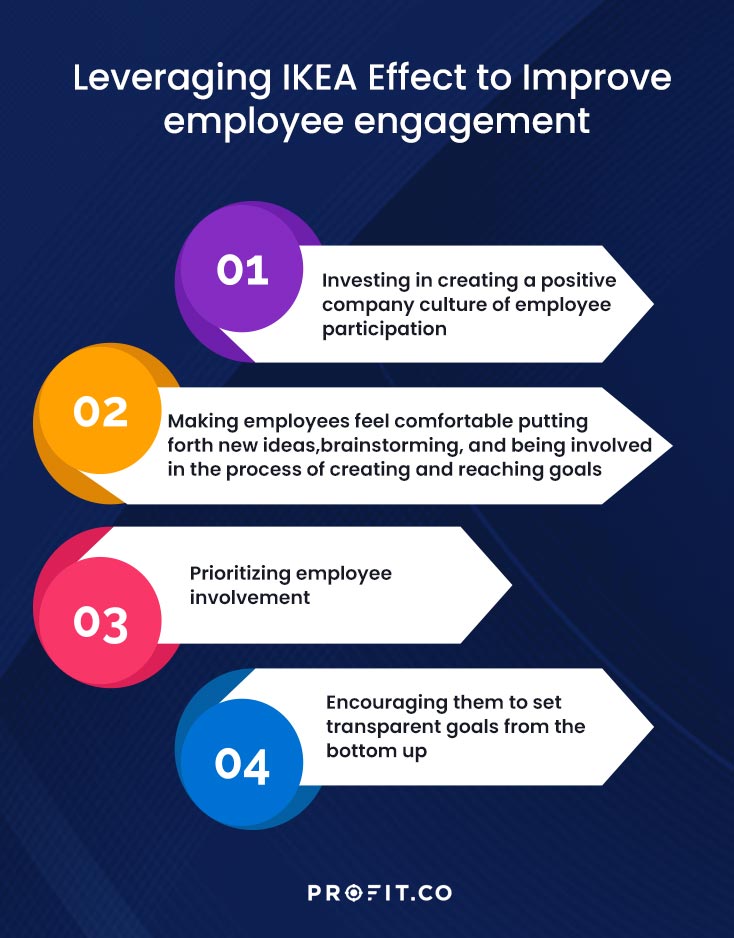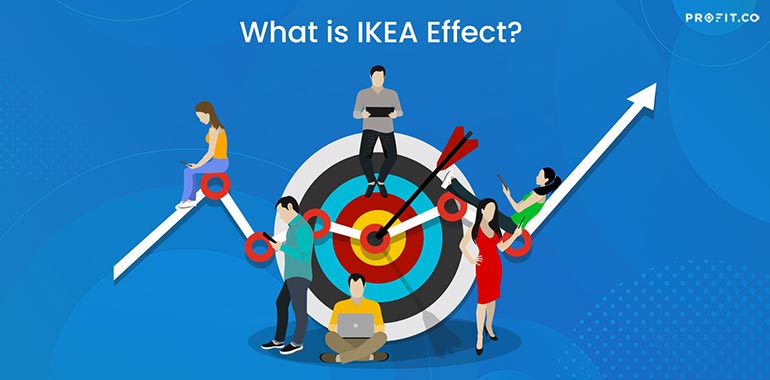How can you leverage the IKEA effect to benefit your business?
Participation and initiative from the self are key driving forces of an engaged workforce. These qualities put into perspective the importance of the role played by every employee in the organization. When they can see how their work, personal achievements or ideas/suggestions go into building the organization and powering its growth, it gives them a feeling of accomplishment. It gives them a feeling of being directly involved in building the organization. This fondness for being involved in making something has its roots in a phenomenon called the IKEA effect.
IKEA Effect – Definition
IKEA effect can be defined as an appeal to the cognitive bias that makes one like something primarily because of one’s involvement in completing or creating or making/building it.
What is IKEA effect?
IKEA is a globally acclaimed furniture maker famous for making products that encourage self-assembly rather than delivering them fully built out-of-the-box. IKEA built its business by appealing to the buyers’ bias towards the furniture that they themselves put an effort to assemble. It made the customers favor those products and the IKEA brand, and that is how the term ‘IKEA effect’ came into existence.
Michael I. Norton of Harvard Business School, Daniel Mochon of Yale, and Dan Ariely of Duke conducted a series of experiments to investigate the IKEA effect. In this study, participants were split into two groups: builders and non-builders. After each experiment, the researchers held an auction for each self-made product. In the auction, people were willing to pay 63% more for products – be it IKEA furniture, lego toys, or origami creatures – if they were the ones to successfully build them.
IKEA Effect examples
- Food products that fall into the ready-to-cook category, though factory-made, let the customers finish making them by heating or microwaving them, ultimately driving the customers to favor those products.
- Some farms allow customers to pick fruits and vegetables that grow there and bring them for weighing and billing. Customers are ready to pay more for these self-picked fruits and vegetables than for the ones in the supermarket.
- Customizable stationery, phone cases, apparel, coffee mugs, etc., that can be personalized with customers’ own designs act as the canvas for customers’ creativity and push them towards liking these products.
- Sandwich/ice cream outlets that allow customers to pick their own toppings, sauces, seasonings and fillings let customers customize their orders to their taste and preferences.
- Toys for children that require assembly give children the sense of creating something and make them favor these toys.
Simplicity and common sense should characterize planning and strategic direction
IKEA Effect to solve problems in business organizations
IKEA effect reveals our human tendency to love the things we create or contribute to. This behavioral economics principle has broad implications for businesses. IKEA effect can be leveraged by business leaders to solve one of the most important problems faced by business organizations today.

Lack of employee engagement in organizations
Employee engagement has come to be considered one of the most important pillars of a successful corporate strategy. In studies conducted by the Queens School of Business and the Gallup Organization,
Disengaged workers had:
- 37% higher absenteeism
- 49% more accidents, and
- 60% more errors
Compared to the organizations with higher employee engagement scores, organizations with low employee engagement scores experienced over time:
- 18% less productivity
- 16% less profitability
- 37% less job growth, and
- 65% less share price
It is evident from these data that employee engagement is a top priority for business leaders to focus on, as it can make a significant difference in the organization.
- The 2018 SHRM/Globoforce Employee Recognition Report throws light on how leaders are using human-centered approaches to resolve retention, recruitment, and culture management challenges. These initiatives have led to an increase in the number of workers who identify themselves as ‘engaged’ in their work.
- Gallup has been measuring and reporting the national figure for employee engagement since 2000, and currently, it’s at an all-time high of 34% in the United States.
While the numbers sound promising and the leaders are already taking steps to ensure higher employee engagement, employee engagement is nowhere near ideal levels in US.
- According to a study by Gallup, a whopping 53% of all American workers still remain unengaged, feeling unattached from their work and their workplace.
Reasons for lack of employee engagement
There are a myriad of reasons these employees could feel unengaged. Their motivation for working may rest solely on personal gain, or perhaps they feel aimless, burnt out, or even bored. Making tasks too easy or too mechanical can also stifle engagement, producing apathy or a sense of purposelessness.
Leveraging IKEA effect to improve employee engagement
To avoid these impediments in achieving employee engagement, the leaders can induce the IKEA effect and transform the way employees feel about their work. This can be done by:
- Investing in creating a positive company culture of employee participation
- Making employees feel comfortable putting forth new ideas, brainstorming, and being involved in the process of creating and reaching goals
- Prioritizing employee involvement
- Encouraging them to set transparent goals from the bottom up
Goal-setting process – an opportunity to engage your employees
Goal-setting should be collaborative, and it should be an ongoing process of measuring, tracking, and aligning employee efforts to company objectives. However, according to Deloitte, a leading management consulting firm, only 51% of companies attempt to develop aligned goals, and, among these, only 6% regularly revisit them. Moreover, Harvard Business Review (HBR) conducted a 9-year study that included more than 40 experiments and surveyed 8,000 managers in more than 250 companies. HBR researchers found that less than ⅓ of senior executives and 16% of frontline employees truly understood how strategic objectives connect with corporate priorities.
To avoid these problems, firms should adopt a system that helps everyone clearly define and track objectives as well as Key Performance Indicators. Bruce Gil notes that cascading goals from the top-down align teams, however, over-alignment can lead back to the stifling of creativity and individual motivation. Organizations need to find a balance between collective commitment and creative freedom. This is where bottom-up OKRs come in as okrs enhance employee engagement.
Want to get started on an intuitive performance management software that can improve employee engagement? Start your free trial of Profit.co!
Creating the IKEA effect through bottom-up OKR goal setting
OKR culture embraces collaborative goal setting from the bottom-up. No two employees are alike. That is, everyone has different work styles, expectations, and values. Employee engagement is a highly personal process and needs to be recognized and addressed as such. Organizations that rely on broad, top-down engagement strategies are in danger of a complete lack of employee engagement. However, in utilizing OKRs, individuals are encouraged to create their own personal objectives and key results which align with team, department, and company goals.
When you encourage this bottom-up process, you can see the IKEA effect at play. When employees set their own goals that align with top level goals, they value the goals even more than those objectives that are passed down to them. If employees can contribute to their company’s goals in tangible ways, they will take up ownership and hold their own work in higher regard, causing them to perform better and positively influence their peers and co-workers.
Why does IKEA effect work in a business organization?
IKEA effect is seen in the organization when the employees seek to fulfill their psychological needs at work. IKEA effect works in a business organization and creates employee engagement because it impacts the mindset of the employees in the following ways.
1. Employees want to see the outcomes of the effort they put in
Organizations go through numerous challenges on any given day, and when employees are allowed to participate in overcoming these challenges, they want to see the value for their effort and participation in the form of favorable outcomes. When their involvement produces great outcomes, they feel inclined to value their work more, as those outcomes are the fruits of their efforts and contributions. As a result, they take ownership of their work and start loving it. IKEA effect helps them justify the efforts and pains they took in order to bring results for the organization. As a result, they will always be ready to engage and eager to participate.
2. Doing something important and achieving results proves their skill, purpose and competency
When employees work hard and participate in creating success for the organization, they see those achievements as proof of their skills and competencies. Those achievements give them a sense of purpose and the reassurance that they are at their competent best. It gives them the motivation to test themselves, push the boundaries, develop themselves further and keep their skills and abilities sharp and up-to-date. It keeps them more engaged and productive.
3. Employees like their name and legacy to be etched in the annals of the organization
When employees participate and make their mark, they see their achievements as a personification of their own valuable selves. Anything that reflects their self-image is endearing to the employees. They see their achievements as the trophies that decorate the organization, carrying their own names and the value they add to the organization. That is why they favor those outcomes.
The dangers of IKEA effect in business
While IKEA effect can be leveraged for the benefit of the organization, there are certain pitfalls in it that the business leaders should be aware of. They need to carefully monitor the situation and avoid these pitfalls.
- The cognitive bias towards one’s own contributions and creations can make the employees feel inclined to overrate their work as well as the outcomes, even if they fall short of the expectations.
- When the outcomes do not match the expectations, it can lead to disagreements with the managers who review the work, and it can give an overwhelming feeling that their work is not valued.
- Such failures and disagreements are counter-productive and can lead to employee dissatisfaction and failure of the organization to bring the best out of the employee. The organization may also fail to retain them.
How to avoid the pitfalls of IKEA effect in business
- The aforementioned pitfalls of the IKEA effect can be avoided by training the employees to self-evaluate their work and the outcomes critically and ascertain the value of the work they have produced in the first place.
- They can also be trained to seek their peers for evaluating their work objectively to make sure that he/she does not completely fall for his/her own IKEA effect bias.
- It is also important to inculcate a culture of open and objective feedback so that the organization as a whole has built-in mechanisms to deal with the pitfalls of the IKEA effect.
Book a free demo with our team to leverage IKEA effect and improve employee engagement.

